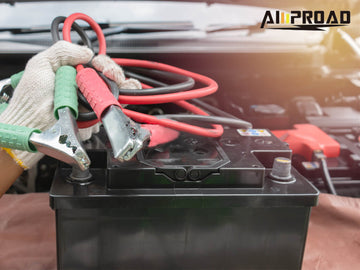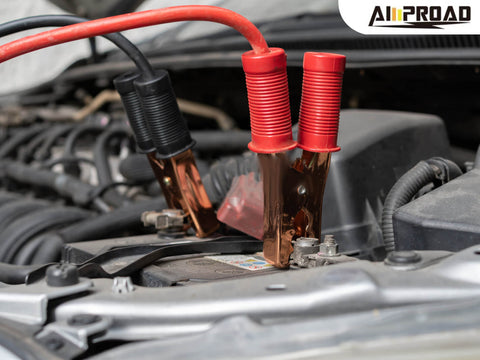
A dead car battery can throw a wrench into your plans, leaving you stranded and frustrated. Fortunately, having a reliable jump starter, like an AMPROAD or Avapow brand on hand can save you time and hassle. This guide will walk you through how to use the AMPROAD or Avapow jump starter to get your car back on the road quickly and safely. Along the way, we'll touch on essential safety tips and practical advice for maintaining your jump starter.
Understanding Your Portable Jump Starter
Before diving into the steps, it’s important to familiarize yourself with the components and features of your jump starter. Typically, a jump starter kit includes:
- The main jump starter unit.
- A set of jumper cables with clamps.
- A charging cable for the jump starter.
- An instruction manual.
- Additional features may include built-in flashlights, USB ports for charging devices, and air compressors.
Key Features
- High Power Output: Good quality jump starters are known for their high power output, capable of jump-starting a range of vehicles including cars, trucks, motorcycles, and even boats.
- Safety Mechanisms: These jump starters come equipped with multiple safety features such as over-current protection, short-circuit protection, overload protection, over-voltage protection, and over-charge protection.
- Portability: Compact and lightweight, making them easy to store in your car and carry around.
- Multi-functionality: Apart from jump-starting vehicles, they often include features like USB ports for charging electronics, built-in LED flashlights, and sometimes even an air compressor for inflating tires.
Steps to Use the Portable Jump Starter

1. Preparation
Before attempting to jump-start your vehicle, ensure you have read the instruction manual that comes how to boost a car with your portable jump starter. This will provide specific details about your model and any unique features it may have. Here are the general preparation steps:
- Charge the Jump Starter: Ensure the jump starter is fully charged before use. Most Avapow jump starters have LED indicators to show the battery level. Charge the unit using the provided cable until it is fully charged.
- Turn Off All Electronics: Make sure your car’s ignition is off, and all electronic devices, such as the radio and lights, are turned off. This minimizes the electrical load and reduces the risk of damage during the jump-starting process.
- Safety Gear: Wear safety gloves and eye protection to prevent injuries from sparks or battery acid.
2. Connecting the Jump Starter
Correctly connecting the avapow 4000a jump starter to your car’s battery is crucial. Here’s how to do it:
- Identify the Battery Terminals: Locate your car battery and identify the positive (+) and negative (-) terminals. The positive terminal is usually marked with a red cap or a plus sign, while the negative terminal may be marked with a black cap or a minus sign.
- Connect the Clamps: Attach the red clamp to the positive terminal of the dead battery. Ensure a secure connection. Next, attach the black clamp to a metal part of the car’s engine block, serving as a grounding point. Avoid connecting it directly to the negative terminal of the dead battery to reduce the risk of sparks.
- Check the Connections: Verify that the clamps are securely attached and not touching any other parts of the engine. Ensure the jump starter unit is placed on a stable surface where it won’t fall or get knocked over.
3. Jump-Starting the Car
With the jump starter connected, you are ready to start your car:
- Power On the Jump Starter: Turn on your Avapow jump starter by pressing the power button. The LED indicators should light up, showing that the unit is operational.
- Start the Car: Try to start your car. Turn the ignition key or press the start button as you normally would. If the engine does not start immediately, wait a few minutes before trying again. This allows the jump starter to deliver a steady flow of current to the battery.
- Successful Start: Once the engine starts, leave it running for a few minutes to allow the alternator to charge the battery.
4. Disconnecting the Jump Starter
Properly disconnecting the jump starter is just as important as connecting it:
- Turn Off the Jump Starter: Turn off the jump starter before removing the clamps.
- Remove the Clamps: First, disconnect the black clamp from the grounding point. Then, remove the red clamp from the positive terminal of the battery.
- Store the Jump Starter: Place the jump starter and its components back in their storage case. Make sure it is stored in a dry, cool place inside your vehicle.
5. Post-Jump Start Steps
After successfully jump-starting your car, consider these additional steps:
- Drive to Recharge: Drive your car for at least 20-30 minutes to allow the alternator to fully recharge the battery. Avoid turning off the engine immediately after the jump-start.
- Check the Battery: If your car frequently needs jump-starting, it may be time to have the battery and electrical system checked by a professional. Persistent issues could indicate a failing battery or a problem with the alternator.
Maintenance Tips for Your Portable Jump Starter

Regular maintenance of your battery booster ensures it is always ready when you need it:
- Keep it Charged: Periodically check the charge level of your jump starter, especially before long trips. Recharge it as necessary to maintain full power.
- Store Properly: Store the jump starter in a cool, dry place. Extreme temperatures can affect the battery’s performance and longevity.
- Inspect for Damage: Regularly inspect the jump starter and cables for any signs of damage or wear. Replace any damaged components to ensure safe operation.
- Use Regularly: Even if you don’t need to jump-start your car often, use the jump starter occasionally to keep its battery in good condition. Many models also have USB ports that can be used to charge devices, helping to keep the unit active.
Safety Considerations
Safety is paramount when using a jump starter. Here are some additional tips to keep in mind:
- Read the Manual: Always refer to the instruction manual specific to your Avapow model. Different models may have unique features and requirements.
- Avoid Flammable Areas: Do not use the jump starter near flammable substances or gases.
- Proper Ventilation: Ensure the area around the battery is well-ventilated. Batteries can emit hydrogen gas, which is flammable.
- Use Correctly: Follow the correct sequence for connecting and disconnecting the jump starter. Incorrect use can lead to sparks, short circuits, or damage to your vehicle’s electrical system.
Troubleshooting Common Issues
Even with proper use, you may encounter some issues while using your Avapow booster batterie. Here are some common problems and their solutions:
The Car Won’t Start
- Check Connections: Ensure the clamps are securely attached to the battery terminals and the grounding point.
- Battery Charge: Make sure the jump starter is fully charged. If not, recharge it before attempting again.
- Wait a Moment: Allow a few minutes for the jump starter to transfer power to the car battery before trying again.
- Inspect Clamps: Check the clamps for any signs of wear or damage that could affect their connection.
The Jump Starter Won’t Power On
- Charge the Unit: Connect the jump starter to a power source and charge it fully.
- Check for Damage: Inspect the jump starter for any visible damage. If the unit is damaged, contact the manufacturer for support.
- Follow Instructions: Ensure you are pressing the correct power button and following the steps outlined in the manual.
The Jump Starter Won’t Hold a Charge
- Frequent Use: Use the jump starter regularly to maintain the battery’s health.
- Proper Storage: Store the unit in a cool, dry place to prevent battery degradation.
- Contact Support: If the jump starter consistently fails to hold a charge, it may need to be replaced. Contact Avapow customer support for assistance.
Jumpstarting with Confidence
Knowing how to use an portable jump starter effectively can save you from the inconvenience and stress of a dead car battery. By understanding the correct procedures for connecting and disconnecting the jump starter, maintaining the device, and following essential safety tips, you can confidently boost your car whenever the need arises. Always keep your jump starter charged and ready, and you’ll have a reliable tool to help you out in emergencies.
Whether you’re a seasoned driver or new to using jump starters, following these guidelines ensures a safe and successful jump start every time. Remember, preparation and proper usage are key to keeping your vehicle’s battery in good shape and ensuring you’re never left stranded.


